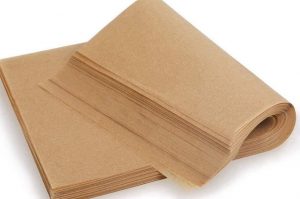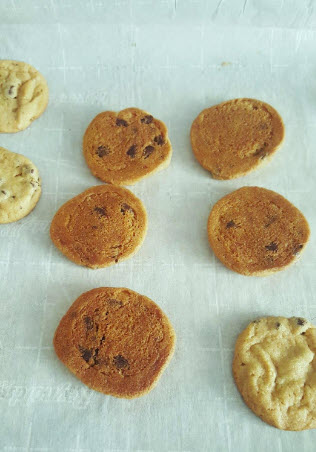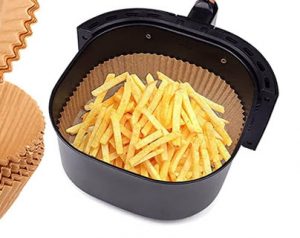Today’s question of the day: Can you use parchment paper in the oven? Many home cooks and even professional chefs have questioned the safety and practicality of using parchment paper when baking. Parchment paper has its advantages, such as providing a non-stick surface and minimizing the need for greasing the pan, but it’s essential to know when and how to use it correctly.
Parchment paper can safely be used in the oven, as it is specifically designed for the high temperatures that come with baking and cooking. However, you should always make sure to use it properly and follow the label. In this post, we’ll discuss the pros and cons of parchment paper, the appropriate temperature range, and some useful tips and tricks.
What is Parchment Paper?
 Parchment paper, also known as baking paper or bakery release paper, is a grease-resistant and heat-resistant paper used primarily in baking and cooking. This non-stick surface is achieved by coating the paper in silicone – the same substance used to produce many non-stick utensils and baking mats.
Parchment paper, also known as baking paper or bakery release paper, is a grease-resistant and heat-resistant paper used primarily in baking and cooking. This non-stick surface is achieved by coating the paper in silicone – the same substance used to produce many non-stick utensils and baking mats.
Available in rolls or pre-cut sheets, parchment paper has a number of uses in the kitchen. Some common uses include:
- Line baking sheets and pans for easy cleanup
- Prevent foods from sticking to bakeware
- Allow for even heat distribution during baking
- Hold food in place for piping or decoration
 Parchment paper is a versatile tool for various cooking techniques. It can be used in techniques such as en papillote, where food is cooked inside a parchment paper pouch, as well as for parcel cooking or steaming.
Parchment paper is a versatile tool for various cooking techniques. It can be used in techniques such as en papillote, where food is cooked inside a parchment paper pouch, as well as for parcel cooking or steaming.
Important tip! Parchment paper should not be confused with wax paper. While both have non-stick properties, wax paper is not heat-resistant, and using it in the oven can result in a fire or wax melting onto the food.
Benefits of Using Parchment Paper in the Oven
Using parchment paper in the oven offers several advantages that make it popular among home cooks and professional chefs alike.
 First, parchment paper prevents food from sticking to the baking sheet or pan. This nonstick quality means you can easily remove your baked goods from the surface without worry of tearing or causing damage. It also makes for simple clean up afterward.
First, parchment paper prevents food from sticking to the baking sheet or pan. This nonstick quality means you can easily remove your baked goods from the surface without worry of tearing or causing damage. It also makes for simple clean up afterward.
Parchment paper is heat resistant up to temperatures of around 420°F (215°C), making it safe to use in most baking and cooking situations.
Using parchment paper can promote even cooking and browning. It helps to insulate the food from direct contact with the baking sheet or pan, thus preventing scorching and ensuring a uniform distribution of heat.
- Convenience: Easy to use and disposable, reducing cleaning time.
- Healthier cooking: Reduces the need for additional cooking fats or oils.
- Versatility: Can be used for various baking and cooking methods.
In addition to these benefits, parchment paper can be used for various other cooking techniques such as:
| En papillote: | Sealing food in parchment paper packets to steam and retain moisture. |
| Layering: | Separating layers of baked goods to prevent sticking during storage. |
| Shaping: | Using parchment paper as a guide for shaping dough or other items. |
Potential Drawbacks and Precautions
While using parchment paper in the oven can offer numerous benefits, there are some potential drawbacks and precautions to consider.
Firstly, it is essential to pay attention to the parchment paper’s temperature limit. As we mentioned, most parchment papers are heat resistant up to temperatures between 420-450°F (215-232°C). Exceeding the recommended temperature limit could result in the paper burning or releasing potentially harmful fumes. Therefore, it is always advised to check the manufacturer’s guidelines before using parchment paper in your oven.
Another point of concern is the proper use of parchment paper to avoid creating a potential fire hazard. To minimize the risk, take care of the following:
- Never use parchment paper under a broiler, as the intense heat could cause it to ignite.
- Avoid direct contact between parchment paper and open flames or heating elements.
- Do not reuse parchment paper that has become stained or torn, as it may not provide the same level of safety and effectiveness.
Lastly, while parchment paper is a convenient and versatile option, it does create waste as it is a single-use product. Environmentally conscious bakers may want to consider using alternatives such as silicone baking mats or reusable oven liners. These eco-friendly options can provide similar results, without generating additional waste.
How to Use Parchment Paper in the Oven
Parchment paper is a versatile and useful tool for making your baking and cooking experiences more enjoyable. When you’re ready to use it in the oven, follow these simple steps to ensure success:
- Preheat your oven according to your recipe’s instructions.
- Cut the parchment paper to fit the size of your baking sheet, dish, or pan, leaving a small overhang on the edges for easy removal.
- Place the parchment paper on your baking sheet, dish, or pan, ensuring it covers the entire surface.
- Add your ingredients on top of the parchment paper, spreading them out evenly.
- Follow the cooking or baking time recommended by your recipe, and adjust as necessary based on your oven’s performance.
- Remove your baked goods or cooked items from the oven, and gently lift the edges of the parchment paper to transfer them to a cooling rack or serving plate.
Additionally, when using parchment paper for more delicate or sticky items like cookies, cakes, or pastries, we often use a small amount of non-stick spray or butter on the paper to prevent sticking. This will make it even easier to remove your baked goods once they’re finished cooking.
Types of Parchment Paper
There are various types of baking parchment paper available, and they differ based on the materials and coatings used. Here are a few common types:
- Unbleached parchment paper: Made from unbleached pulp, this type of parchment paper is usually brown and more eco-friendly due to the absence of chemical treatments during processing.
- Bleached parchment paper: This type of parchment paper undergoes a bleaching process, resulting in a white color. The bleaching process helps improve the cleanliness and appearance of the paper.
- Quilon-coated parchment paper: Quilon is a chemical treatment used to provide a non-stick surface to the parchment paper. While cost-effective, it is not as durable as silicone and may not be ideal for high-temperature baking.
- Silicone-coated parchment paper: This type of parchment paper is coated with a thin layer of silicone, providing a superior non-stick surface. It is more durable and can withstand higher temperatures than Quilon-coated paper.
When using baking parchment paper, it’s essential to choose the appropriate type based on your specific baking needs. Factors such as the temperature, baking time, and the desired result should be considered before making your selection.
 There is also pre-cut parchment paper which is a convenient option for those who need parchment for various baking tasks. As the name suggests, it comes in pre-cut sheets, usually sized to fit standard baking trays and pans.
There is also pre-cut parchment paper which is a convenient option for those who need parchment for various baking tasks. As the name suggests, it comes in pre-cut sheets, usually sized to fit standard baking trays and pans.
Some manufacturers even make molded parchment to fit nicely in air fryers!
Conclusion
Parchment paper can be safely used in the oven for various baking and cooking purposes. Its heat-resistant and non-stick properties make it an advantageous choice for tasks such as lining baking sheets and wrapping food items.
When using parchment paper, it is important to:
- Check the maximum recommended temperature on the product packaging
- Avoid exposing parchment paper to direct heat sources, such as open flames or broilers
- Ensure proper ventilation when using it to prevent curling or fire hazards
By following these guidelines, parchment paper can be a valuable addition to your kitchen, simplifying the cooking and cleaning process and delivering reliable, consistent results.
